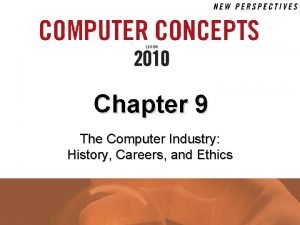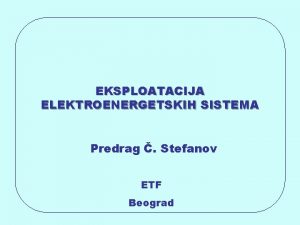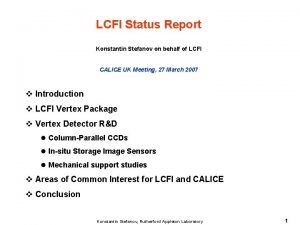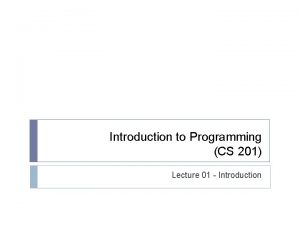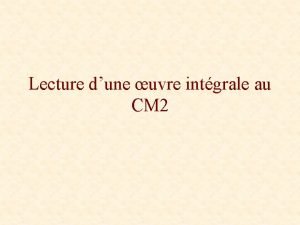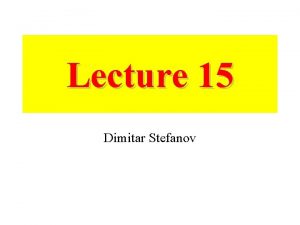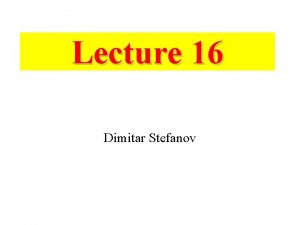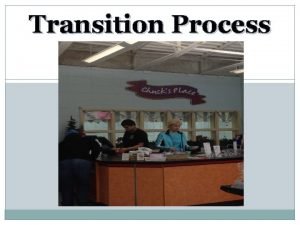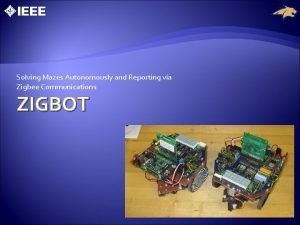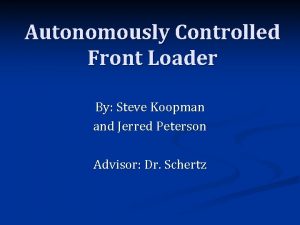Lecture 22 Dimitar Stefanov Gotogoal wheelchairs Autonomously transition


















- Slides: 18

Lecture 22 Dimitar Stefanov

Go-to-goal wheelchairs Autonomously transition a wheeled vehicle from an initial position/orientation . . . to a desired position/orientation. . . and/or follow a desired path. . . without striking obstacles or endangering load or environment.

Nonholonomic Kinematics What is the relationship between movement of the two wheel rotations (which can be controlled separately and directly) and the vehicle's changing location and orientation on the floor?

Comparison of Nonholonomic and Holonomic Kinematics What characteristics distinguishes a nonholonomic system from a holonomic system?

A qualitative comparison of a holonomic system (the robotic arm) and a nonholonomic system (the wheelchair), both moving in the X-Y plane. At both the initial and final positions, the rotation of each wheel is exactly zero degrees. The final location of the wheelchair, however, is clearly changed. At both the initial and final locations, the rotation of each link is exactly ten degrees. In this case, the final location of the robot's end effector is, and must be, exactly the same as the initial location.

What distinguishes a nonholonomic system from a holonomic system? 1. With a holonomic system, return to the original internal (joint) configuration means return to the original system position. 2. With a nonholonomic system, return to the original internal (wheel) configuration does not guarantee return to the original system position. The system outcome for a nonholonomic system is pathdependent.

1. Holonomic kinematics can be expressed in terms of algebraic equations which constrain the internal, rotational coordinates of a robot to the absolute position/orientation of the body of interest. 2. Nonholonomic kinematics are expressible with differential relationships only.

Kinematic equations of motion (KEM) KEM give the relationship between wheel rotation and the position/orientation of the base. First we define as shown. Note that X and Y denote the in-plane position of the midpoint of the axle.

Define: Then: (1) ; (2) (3) Define: Then, equations (1 -3) have the form of time-independent state equations: (4)

Dead reckoning Derived from “deduced reckoning used in sailing. Mathematical procedure for determining the present location by knowing some previous position through known course and velocity information over a given length of time. Sometimes called “odometry” Optical encoders directly coupled to the motor armatures or wheel axles. Another solution - permanent magnets, attached to wheel and magnetic sensor Inductive sensors are also used. Heading information:

Example: straight-line motion where: D = vehicle displacement along path; Θ = vehicle heading Differential steering Robot displacement D along the path is given by the equation: (5)

The platform velocity V is given by the equation: (5)

(6) Combining (5) and (6) Similarly:

1. The change of vehicle orientation Θ is a function of the displacement of the left and right drive wheels. 2. The vehicle orientation Θ doesn’t depend on the path taken. The distance (d) between wheels is a source of errors: Uncertainties in the contact between the tire and floor introduce an error in the distance d. This error varies up to 2 W. Non-planar irregularities – source of additional angular error.

The displacement of the left wheel is not exactly Dl Tire compliance is additional error source! Expressing the last equation in terms of encoder counts gives:

Similarly, for the left drive wheel:

Negative effects due to bumps or cracks in the floor surface Dm – measured rotation Dh – actual horizontal distance traveled Linear error Dm – Dh. The displacement ΔΘ between left and right drive wheels Where: d is the distance between the drive wheels

Another error source – slippage between tire and floor surface due to grease, oil, fluid spills, excessive acceleration or deceleration of the platform. Skid sleeping
 A manual calculator implements algorithms autonomously.
A manual calculator implements algorithms autonomously. Gotogoal
Gotogoal Stamen grigorov
Stamen grigorov Koga e roden vasil levski
Koga e roden vasil levski Dimitar sasselov
Dimitar sasselov Predrag stefanov
Predrag stefanov Konstantin stefanov
Konstantin stefanov 01:640:244 lecture notes - lecture 15: plat, idah, farad
01:640:244 lecture notes - lecture 15: plat, idah, farad Professor green lecture 1
Professor green lecture 1 Philosopher giving a lecture on the orrery
Philosopher giving a lecture on the orrery Data visualization lecture
Data visualization lecture Utilities and energy lecture
Utilities and energy lecture Contemporary
Contemporary Operating systems lecture notes
Operating systems lecture notes Parallel and distributed computing lecture notes
Parallel and distributed computing lecture notes Cs201 ppt slides
Cs201 ppt slides Foundation engineering lecture notes
Foundation engineering lecture notes Résumé du livre tirez pas sur le scarabée
Résumé du livre tirez pas sur le scarabée Othello lecture
Othello lecture
